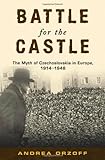|
|
Help |
| Home - Basic S - Slovakia Culture (Books) | |
e99 Online Shopping Mall
|
|
Help |
| Home - Basic S - Slovakia Culture (Books) | |
| Back | 41-48 of 48 |
click price to see details click image to enlarge click link to go to the store
| 41. European Culture and Heritage a Destination Specialist Course Part 2 (central europe belgium, netherlands, luxenbourg, germany, switzerland, and austria. Eastern Europe- Poland, czech republic, slovakia, and hungary) by the travel institute | |
| Spiral-bound:
Pages
(2004)
Asin: B001M5PMHI Canada | United Kingdom | Germany | France | Japan | |
| 42. Stránská skála: Origins of the Upper Paleolithic in the Brno Basin, Moravia, Czech Republic (Bulletin (American School of Prehistoric Research)) | |
| Paperback: 232
Pages
(2005-04-30)
list price: US$50.00 -- used & new: US$49.97 (price subject to change: see help) Asin: 0873655516 Canada | United Kingdom | Germany | France | Japan | |
|
Editorial Review Product Description In this volume, an international and interdisciplinary team of scholars—Czech and American archaeologists, paleoanthropologists, geologists, and biologists—report on the results of the investigations from 1980 through the 1990s at Stránská skála, a complex of open-air loess sites on the outskirts of the Brno Basin in the Czech Republic. The volume presents in-depth studies of the geology, paleopedology, frost processes, vegetation, fauna, and archaeological features of Stránská skála that break new ground in our understanding of early modern humans in central Europe. | |
| 43. Local Democracy and the Processes of Transformation in East-Central Europe (Urban Policy Challenges) | |
| Hardcover: 257
Pages
(1996-02)
list price: US$69.00 Isbn: 0813389682 Canada | United Kingdom | Germany | France | Japan | |
|
Editorial Review Product Description | |
| 44. Battle for the Castle: The Myth of Czechoslovakia in Europe, 1914-1948 by Andrea Orzoff | |
 | Hardcover: 308
Pages
(2009-07-21)
list price: US$74.00 -- used & new: US$69.41 (price subject to change: see help) Asin: 0195367812 Canada | United Kingdom | Germany | France | Japan |
|
Editorial Review Product Description | |
| 45. Pink Tanks and Velvet Hangovers by Douglas Lytle | |
 | Paperback: 250
Pages
(1995-03-07)
list price: US$16.95 -- used & new: US$12.44 (price subject to change: see help) Asin: 1883319242 Average Customer Review: Canada | United Kingdom | Germany | France | Japan |
|
Editorial Review Product Description Customer Reviews (6)
| |
| 46. Prague Panoramas: National Memory and Sacred Space in the Twentieth Century (Pitt Russian East European) by Cynthia Paces | |
| Hardcover: 352
Pages
(2009-09-28)
list price: US$65.00 -- used & new: US$64.97 (price subject to change: see help) Asin: 0822943751 Canada | United Kingdom | Germany | France | Japan | |
|
Editorial Review Product Description | |
| 47. Flag Wars and Stone Saints: How the Bohemian Lands Became Czech by Nancy M. Wingfield | |
 | Hardcover: 374
Pages
(2007-10-31)
list price: US$54.50 -- used & new: US$53.89 (price subject to change: see help) Asin: 0674025822 Canada | United Kingdom | Germany | France | Japan |
|
Editorial Review Product Description In a new perspective on the formation of national identity in Central Europe, Nancy Wingfield analyzes what many historians have treated separately--the construction of the Czech and German nations--as a larger single phenomenon. Czech and German nationalism worked off each other in dynamic ways. As external conditions changed, Czech and German nationalists found new uses for their pasts and new ways to stage them in public spaces for their ongoing national projects. These grassroots confrontations transformed public culture by reinforcing the centrality of nationality to everyday life and by tying nationalism to the exercise of power. The battles in the public sphere produced a cultural geography of national conflict associated with the unveiling of Joseph II statues that began in 1881, the Badeni Language Ordinances of 1897, the 1905 debate over a Czech-language university in Moravia, and the celebration of the emperor's sixtieth jubilee in 1908. The pattern of impassioned national conflict would be repeated for the duration of the monarchy and persist with even more violence into the First Czechoslovak Republic. Numerous illustrations show how people absorbed, on many levels, visual clues that shaped how they identified themselves and their groups. This nuanced analysis is a valuable contribution to our understanding of Central European history, nationalism, and the uses of collective memory. | |
| 48. Magic Prague by Angelo Maria Ripellino | |
 | Hardcover: 333
Pages
(1993-12-10)
list price: US$40.00 -- used & new: US$89.95 (price subject to change: see help) Asin: 0520073525 Average Customer Review: Canada | United Kingdom | Germany | France | Japan |
|
Editorial Review Product Description Customer Reviews (6)
| |
| Back | 41-48 of 48 |